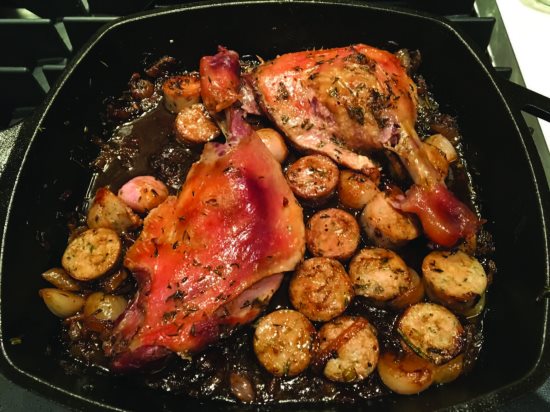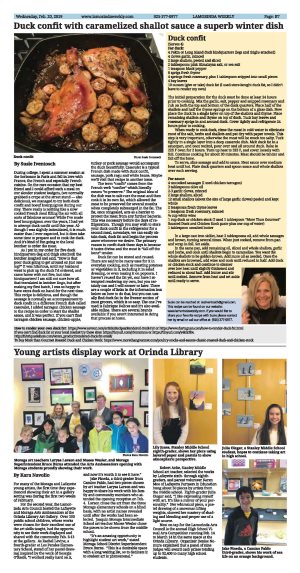| | Published February 20th, 2019
| Duck confit with caramelized shallot sauce a superb winter dish
| | | By Susie Iventosch |  | | Duck confit Photo Susie Iventosch |
During college, I spent a summer session at the Sorbonne in Paris and fell in love with France, the French and especially French cuisine. On the rare occasion that my best friend and I could afford such a meal on our slender student budgets, (we normally grabbed a crepe at the street stand - also delicious), we managed to try both duck confit and boeuf bourguignon during our stay. There really is nothing like a slow cooked French meal filling the air with all sorts of fabulous aromas! While I've made beef bourguignon over the years, I had yet to attempt duck confit until this year. Although I was slightly intimidated, it is much easier than I ever expected, but it does take some time to prepare and to cook the duck. And it's kind of fun going to the local butcher to order the meat.
 As I put in my order for five duck hindquarters (leg and thigh attached) the butcher laughed and said, "How is that poor duck going to get around on just one leg?" It was hilarious, until my husband went to pick up the duck I'd ordered, and came home with not five, but nine hindquarters! I am still not sure how all that translated in butcher lingo, but after making my first batch, I was so happy to have extra duck on hand for the next time. This recipe is delicious, and though the sausage is normally an accompaniment to duck confit in a different French dish called cassoulet, I added tarragon chicken sausage to the recipe in order to start the shallot sauce, and it was perfect. If you can't find tarragon chicken sausage, chicken-apple, turkey or pork sausage would accompany the duck beautifully. Cassoulet is a typical French dish made with duck confit, sausage, pork ragu and white beans. Maybe we'll visit that recipe in another issue.
As I put in my order for five duck hindquarters (leg and thigh attached) the butcher laughed and said, "How is that poor duck going to get around on just one leg?" It was hilarious, until my husband went to pick up the duck I'd ordered, and came home with not five, but nine hindquarters! I am still not sure how all that translated in butcher lingo, but after making my first batch, I was so happy to have extra duck on hand for the next time. This recipe is delicious, and though the sausage is normally an accompaniment to duck confit in a different French dish called cassoulet, I added tarragon chicken sausage to the recipe in order to start the shallot sauce, and it was perfect. If you can't find tarragon chicken sausage, chicken-apple, turkey or pork sausage would accompany the duck beautifully. Cassoulet is a typical French dish made with duck confit, sausage, pork ragu and white beans. Maybe we'll visit that recipe in another issue.
 The term "confit" comes from the French verb "confire" which literally means "to preserve." The original idea of the dish was to salt-cure the meat and then cook it in its own fat, which allowed the meat to be preserved for several months when completely submerged in the fat. The fat, once congealed, acts as a barrier to protect the meat from any further bacteria. This was necessary before the days of refrigeration. Though you may wish to store your duck confit in the refrigerator for a second meal, nowadays, we can easily obtain duck, duck fat and begin the process anew whenever we desire. The primary reason to confit duck these days is because it tastes divine and the meat is "fall off the bone" tender.
The term "confit" comes from the French verb "confire" which literally means "to preserve." The original idea of the dish was to salt-cure the meat and then cook it in its own fat, which allowed the meat to be preserved for several months when completely submerged in the fat. The fat, once congealed, acts as a barrier to protect the meat from any further bacteria. This was necessary before the days of refrigeration. Though you may wish to store your duck confit in the refrigerator for a second meal, nowadays, we can easily obtain duck, duck fat and begin the process anew whenever we desire. The primary reason to confit duck these days is because it tastes divine and the meat is "fall off the bone" tender.
 Duck fat can be stored and reused. There are said to be many uses for it in everyday cooking, such as roasting potatoes or vegetables in it, including it in salad dressing, or even tossing it on popcorn. I haven't reused the fat yet, nor have I attempted rendering my own, but you certainly can and I will sooner or later. There are a couple of links in the information box below on how to do that, but you can usually find duck fat in the freezer section of most grocers, which is so easy. The one I've used is Fabrique Delices and it's also available online. There are several brands available if you aren't interested in doing that process at home.
Duck fat can be stored and reused. There are said to be many uses for it in everyday cooking, such as roasting potatoes or vegetables in it, including it in salad dressing, or even tossing it on popcorn. I haven't reused the fat yet, nor have I attempted rendering my own, but you certainly can and I will sooner or later. There are a couple of links in the information box below on how to do that, but you can usually find duck fat in the freezer section of most grocers, which is so easy. The one I've used is Fabrique Delices and it's also available online. There are several brands available if you aren't interested in doing that process at home.
 How to render your own duck fat: https://www.saveur.com/article/Recipes/Rendered-Duck-Fat or https://www.dartagnan.com/how-to-render-duck-fat.html
How to render your own duck fat: https://www.saveur.com/article/Recipes/Rendered-Duck-Fat or https://www.dartagnan.com/how-to-render-duck-fat.html
 If you can't find duck fat at your local market try these sites: https://tinyurl.com/y5rmxmnu or https://tinyurl.com/y4ktx3bu
If you can't find duck fat at your local market try these sites: https://tinyurl.com/y5rmxmnu or https://tinyurl.com/y4ktx3bu
 http://fabriquedelices.com/wmm_product/rendered-duck-fat-small/
http://fabriquedelices.com/wmm_product/rendered-duck-fat-small/
 To buy More than Gourmet Roasted Duck and Chicken Stock: https://www.morethangourmet.com/poultry-stocks-and-sauces-classic-roasted-duck-and-chicken-stock
To buy More than Gourmet Roasted Duck and Chicken Stock: https://www.morethangourmet.com/poultry-stocks-and-sauces-classic-roasted-duck-and-chicken-stock |
 | | Susie can be reached at suziventosch@gmail.com. This recipe can be found on our website: www.lamorindaweekly.com. If you would like to share your favorite recipe with Susie please contact her by email or call our office at (925) 377-0977. | Duck confit
| | | | | | | |
(Serves 4)
 For duck:
For duck:
 4 Pekin or Long Island duck hindquarters (legs and thighs attached)
4 Pekin or Long Island duck hindquarters (legs and thighs attached)
 4 cloves garlic, minced
4 cloves garlic, minced
 2 large shallots, peeled and sliced
2 large shallots, peeled and sliced
 2 tablespoons pink Himalayan salt, or sea salt
2 tablespoons pink Himalayan salt, or sea salt
 1 teaspoon black pepper
1 teaspoon black pepper
 8 sprigs fresh thyme
8 sprigs fresh thyme
 4 springs fresh rosemary, plus 1 tablespoon snipped into small pieces
4 springs fresh rosemary, plus 1 tablespoon snipped into small pieces
 4 bay leaves
4 bay leaves
 10 ounces (give or take) duck fat (I used store-bought duck fat, so I didn't have to render my own)
10 ounces (give or take) duck fat (I used store-bought duck fat, so I didn't have to render my own)

 The initial preparation for the duck must be done at least 24 hours prior to cooking. Mix the garlic, salt, pepper and snipped rosemary and rub on both the top and bottom of the duck quarters. Place half of the shallots and half the thyme springs on the bottom of a glass dish. Now place the duck in a single layer on top of the shallots and thyme. Place remaining shallots and thyme on top of duck. Tuck bay leaves and rosemary sprigs in and around duck. Cover tightly and refrigerate 24 hours prior to cooking.
The initial preparation for the duck must be done at least 24 hours prior to cooking. Mix the garlic, salt, pepper and snipped rosemary and rub on both the top and bottom of the duck quarters. Place half of the shallots and half the thyme springs on the bottom of a glass dish. Now place the duck in a single layer on top of the shallots and thyme. Place remaining shallots and thyme on top of duck. Tuck bay leaves and rosemary sprigs in and around duck. Cover tightly and refrigerate 24 hours prior to cooking.
 When ready to cook duck, rinse the meat in cold water to eliminate most of the salt, herbs and shallots and pat dry with paper towels. This step is very important, otherwise the meat will be much too salty. Tuck tightly in a single layer into a deep casserole dish. Melt duck fat in a saucepan, and once melted, pour over and all around duck. Bake in 225 F oven for 2 hours. Turn up heat to 325 F, and cover loosely with foil. Continue cooking for about 30 minutes. Meat should be tender and fall off the bone.
When ready to cook duck, rinse the meat in cold water to eliminate most of the salt, herbs and shallots and pat dry with paper towels. This step is very important, otherwise the meat will be much too salty. Tuck tightly in a single layer into a deep casserole dish. Melt duck fat in a saucepan, and once melted, pour over and all around duck. Bake in 225 F oven for 2 hours. Turn up heat to 325 F, and cover loosely with foil. Continue cooking for about 30 minutes. Meat should be tender and fall off the bone.
 To serve, slice sausage and add to sauce. Heat sauce over medium heat until hot. Plate duck quarters and spoon sauce and whole shallots over each serving.
To serve, slice sausage and add to sauce. Heat sauce over medium heat until hot. Plate duck quarters and spoon sauce and whole shallots over each serving.

 For sauce:
For sauce:
 4 uncooked sausages (I used chicken-tarragon)
4 uncooked sausages (I used chicken-tarragon)
 3 tablespoons olive oil
3 tablespoons olive oil
 2-3 garlic cloves, minced
2-3 garlic cloves, minced
 2 large shallots, sliced
2 large shallots, sliced
 12 small shallots (about the size of large garlic cloves) peeled and kept whole
12 small shallots (about the size of large garlic cloves) peeled and kept whole
 2 teaspoons fresh thyme leaves
2 teaspoons fresh thyme leaves
 1 teaspoon fresh rosemary, minced
1 teaspoon fresh rosemary, minced
 1/2 cup white wine
1/2 cup white wine
 1 cup duck or chicken stock (I used 1 tablespoon "More Than Gourmet" Roasted Duck and Chicken Stock paste plus one cup of water)
1 cup duck or chicken stock (I used 1 tablespoon "More Than Gourmet" Roasted Duck and Chicken Stock paste plus one cup of water)
 1 tablespoon unsalted butter
1 tablespoon unsalted butter

 In a large cast iron skillet, heat 2 tablespoons oil, add whole sausages and brown, turning several times. When just cooked, remove from pan and wrap in foil. Set aside.
In a large cast iron skillet, heat 2 tablespoons oil, add whole sausages and brown, turning several times. When just cooked, remove from pan and wrap in foil. Set aside.
 In the same pan, add remaining oil, sliced and whole shallots, garlic and herbs, and cook until shallots begin to caramelize. You want the whole shallots to be golden-brown. Add more oil as needed. Once the shallots are browned, add wine and cook until reduced in half. Add duck or chicken stock and continue to simmer over low heat until slightly thickened and reduced to about half. Add butter and stir until melted. Remove from heat and set aside until ready to serve.
In the same pan, add remaining oil, sliced and whole shallots, garlic and herbs, and cook until shallots begin to caramelize. You want the whole shallots to be golden-brown. Add more oil as needed. Once the shallots are browned, add wine and cook until reduced in half. Add duck or chicken stock and continue to simmer over low heat until slightly thickened and reduced to about half. Add butter and stir until melted. Remove from heat and set aside until ready to serve. | | | | | | | | | | | |




